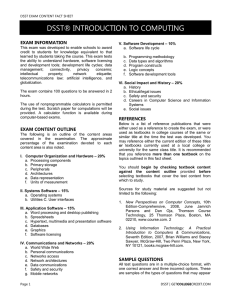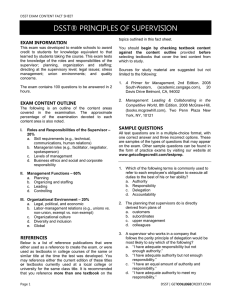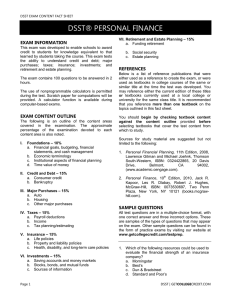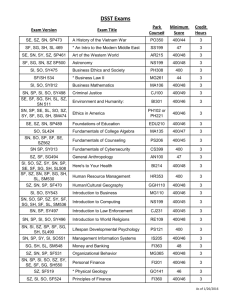DSST® ENVIRONMENT & HUMANITY: THE RACE TO SAVE THE PLANET EXAM INFORMATION
advertisement
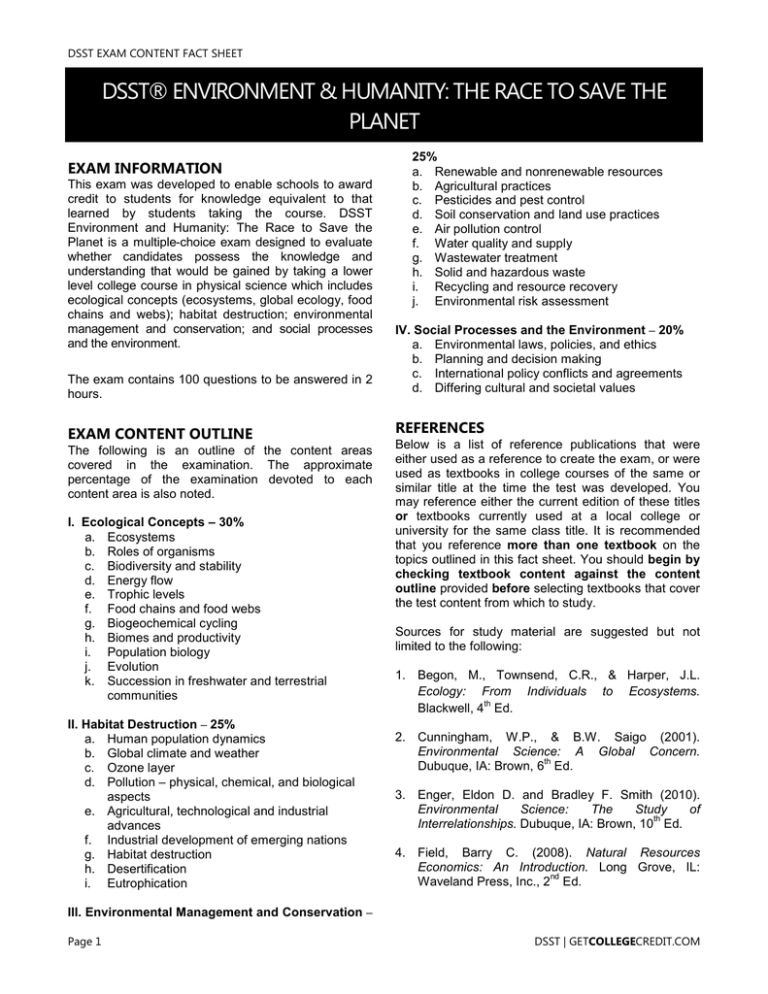
DSST EXAM CONTENT FACT SHEET DSST® ENVIRONMENT & HUMANITY: THE RACE TO SAVE THE PLANET EXAM INFORMATION This exam was developed to enable schools to award credit to students for knowledge equivalent to that learned by students taking the course. DSST Environment and Humanity: The Race to Save the Planet is a multiple-choice exam designed to evaluate whether candidates possess the knowledge and understanding that would be gained by taking a lower level college course in physical science which includes ecological concepts (ecosystems, global ecology, food chains and webs); habitat destruction; environmental management and conservation; and social processes and the environment. 25% a. Renewable and nonrenewable resources b. Agricultural practices c. Pesticides and pest control d. Soil conservation and land use practices e. Air pollution control f. Water quality and supply g. Wastewater treatment h. Solid and hazardous waste i. Recycling and resource recovery j. Environmental risk assessment The exam contains 100 questions to be answered in 2 hours. IV. Social Processes and the Environment – 20% a. Environmental laws, policies, and ethics b. Planning and decision making c. International policy conflicts and agreements d. Differing cultural and societal values EXAM CONTENT OUTLINE REFERENCES The following is an outline of the content areas covered in the examination. The approximate percentage of the examination devoted to each content area is also noted. I. Ecological Concepts – 30% a. Ecosystems b. Roles of organisms c. Biodiversity and stability d. Energy flow e. Trophic levels f. Food chains and food webs g. Biogeochemical cycling h. Biomes and productivity i. Population biology j. Evolution k. Succession in freshwater and terrestrial communities II. Habitat Destruction – 25% a. Human population dynamics b. Global climate and weather c. Ozone layer d. Pollution – physical, chemical, and biological aspects e. Agricultural, technological and industrial advances f. Industrial development of emerging nations g. Habitat destruction h. Desertification i. Eutrophication Below is a list of reference publications that were either used as a reference to create the exam, or were used as textbooks in college courses of the same or similar title at the time the test was developed. You may reference either the current edition of these titles or textbooks currently used at a local college or university for the same class title. It is recommended that you reference more than one textbook on the topics outlined in this fact sheet. You should begin by checking textbook content against the content outline provided before selecting textbooks that cover the test content from which to study. Sources for study material are suggested but not limited to the following: 1. Begon, M., Townsend, C.R., & Harper, J.L. Ecology: From Individuals to Ecosystems. th Blackwell, 4 Ed. 2. Cunningham, W.P., & B.W. Saigo (2001). Environmental Science: A Global Concern. th Dubuque, IA: Brown, 6 Ed. 3. Enger, Eldon D. and Bradley F. Smith (2010). Environmental Science: The Study of th Interrelationships. Dubuque, IA: Brown, 10 Ed. 4. Field, Barry C. (2008). Natural Resources Economics: An Introduction. Long Grove, IL: nd Waveland Press, Inc., 2 Ed. III. Environmental Management and Conservation – Page 1 DSST | GETCOLLEGECREDIT.COM DSST EXAM CONTENT FACT SHEET – ENVIRONMENT & HUMANITY: THE RACE TO SAVE THE PLANET 5. Field, B.C. and M.K. Field. Environmental th Economics: An Introduction. McGraw Hill, 6 Ed. 6. Kütting, Gabriela (2011). Global Environmental Politics: Concepts, Theories and Case Studies. Routledge, current edition. 7. Miller, G. Tyler & Spoolman, Scott E. (2010) Environmental Science. Thomson Brooks/Cole, th 13 Ed. 8. Norton, G.W., Alwang, J., & W.A. Masters. The Economics of Agricultural Development: World nd Food Systems and Resource Use. Routledge, 2 Ed. 9. Robbins, Paul (2012). Political Ecology: A Critical nd Introduction. John Wiley & Sons, 2 Ed. 10. Rulle, Robert. J. The Environment and Society Reader. 1st Ed. 11. TEEB (2011). The Economics of Ecosystems and Biodiversity in National and International Policy Making. Ed. Patrick ten Brink. London and Washington: Earthscan, current edition. 12. TEEB (2010). The Economics of Ecosystems and Biodiversity: Ecological and Economic Foundations. Ed. Pushpam Kumar. London and Washington: Earthscan, current edition. 13. Waskey, Andrew J. (2007) Encyclopedia of Environment and Society. Sage Publications, current edition. 14. Withgott, Jay & Brennan, Scott (2010). Environment: The Science Behind the Stories. th Benjamin Cummings, 4 Ed. SAMPLE QUESTIONS All test questions are in a multiple-choice format, with one correct answer and three incorrect options. These are samples of the types of questions that may appear on the exam. Other sample questions can be found in the form of practice exams by visiting our website at www.getcollegecredit.com/testprep. 1. The primary factor that determines the location and kind of biomes is a. climate b. soil c. altitude d. latitude 2. The oceans play a key role in the recycling of carbon and oxygen because of the productivity of Page 2 a. b. c. d. fish marine mammals phytoplankton zooplankton 3. Early human populations increased rapidly with the widespread adoption of which of the following practices? a. Hunting b. Fishing c. Farming d. Herding 4. Concentrations of carbon dioxide, infrared energy, methane, and water vapor are major contributing factors to a. thermal air inversion b. the greenhouse effect c. urban smog d. acid rain 5. Catalytic converters are used to remove chemicals that contribute to a. lead poisoning b. carbon dioxide asphyxiation c. photochemical smog d. chlorofluorocarbon (CFC) pollution 6. Which of the following countries, with a total fertility rate of less than 2.0, is said to be at "zero population growth"? a. Thailand b. India c. Zimbabwe d. Sweden 7. An oak tree is an example of which of the following? a. Primary producer b. Primary consumer c. Secondary consumer d. Decomposer 8. Incomplete combustion in automobile engines releases which of the following into the atmosphere? a. Radon b. Carbon tetrachloride c. Asbestos d. Hydrocarbons 9. The combined use of fertilizers, pesticides, and hybrid seeds to increase crop yields is characteristic of which of the following? a. The green revolution b. Subsistence farming c. Sustainable yield agriculture d. Agro-forestry DSST | GETCOLLEGECREDIT.COM DSST EXAM CONTENT FACT SHEET – ENVIRONMENT & HUMANITY: THE RACE TO SAVE THE PLANET 10. Which of the following is used to describe all of the living and nonliving features of a given area? a. Community b. Ecosystem c. Biome d. Carrying capacity 11. Recycling of resources is most critical for the conservation of which of the following? a. Biomass b. Food c. Minerals d. Wildlife 12. Which of the following statements is true about the near future of the biosphere? a. Human population will remain stable. b. Coal will be the primary natural energy source. c. The amount of food per person will remain constant. d. Increased industrialization will not increase pollution. CREDIT RECOMMENDATIONS The American Council on Education’s College Credit Recommendation Service (ACE CREDIT) has evaluated the DSST test development process and content of this exam. It has made the following recommendations: Area or Course Equivalent Environment and Humanity: The Race to Save the Planet Level Lower-level baccalaureate Amount of Credit Minimum Score Three (3) semester hours Source American Council on Education – College Credit Recommendation Service 400 Answers to sample questions: 1-A; 2-C; 3-C; 4-B; 5-C; 6D; 7-A; 8-D; 9.A; 10-B; 11-C; 12-B. Page 3 DSST | GETCOLLEGECREDIT.COM DSST EXAM CONTENT FACT SHEET – ENVIRONMENT & HUMANITY: THE RACE TO SAVE THE PLANET Rev 2/2014 Page 4 DSST | GETCOLLEGECREDIT.COM

